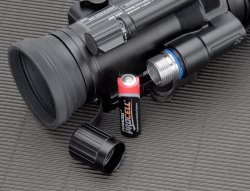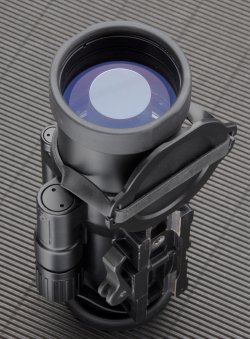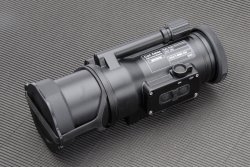
Heir to the well-known Hensoldt NSV 80 Night Vision add-on sight, the NSV 600 is much more compact and lighter than its predecessor, as well as being easier to use with standard scopes thanks to the reduced diameter of the objective lens and resulting lower optical axis with respect to the barrel. Very similar in use, general configuration and size to the AN/PVS 22, jointly developed by KAC and OSTI and commercially known as UNS (Universal Night Sight), the NSV 600 is, in our opinion, an evolution of the latter, also because part (admittedly considerable) of the performance of the PVS 22 is based not only on the optical quality of the “housing” but on the availability of third-generation photo-cathode thin film tubes with FOM and IR sensibility performance that cannot be exported from the USA. Moreover, some features of the NSV 600 are objectively desirable, such as the best available definition of the particular optical scheme on which the equipment is based and the use of an intensifier without inversion of the image, as well as the possibility of digitally interfacing with the CPU integrated into the equipment through a serial IR interface.

The NSV 600 is based on a tough 7075-T6 (Ergal) body that contains all of the lens assembly, the electronics, the IIT tube and the “rail grabber” quick release lever mount attachment, compatible with the Picatinny Mil Std 1913 rails. There is a lens focus control, an on/off switch and two soft touch push buttons for adjusting brightness. The 55 mm lens is catadioptric, with the focal plane corresponding to the photocathode of the intensifier tube, the image is rendered and amplified on the focal plane of the screen's IIT fluorescent tube and inverted by a Schmidt-Pechan prism. The image is then presented to the front lens of the daytime aiming scope with a fixed parallax at 200 m, if the telescope has an adjustable “focus control” this must be set at 200 m. The integrated IIT tube that we tested was a Photonis XD4, in the “auto gated” version; the NSV 600 is also available with the even more attractive XR5 tube. We tested the device on an AR10, with integral RAS handguard and Leupold MK4 M110 optics. The picture quality is excellent up to a magnification of 6x; at 10x, the maximum magnification offered by the daytime scope, the contrast level and definition are reduced but continue to be more than acceptable. With the M110 scope tested, passive observation is possible and almost perfect as long as the light conditions are all the way to clear nights, no moon or lights from nearby cities and only with star light illumination; it is still possible to use the telescope in cloudy sky conditions or in the forest (where usefulness of such a device may be debatable) but the identification of the target is not certain.

POI (point Of Impact) variation with respect to the aiming point is about 0.5 MOA, while the mount repeatability did not produce significant changes at the test distance (100 m). The ergonomics of the controls is good but not excellent, also because of the position of the instrument, virtually at the end of the handguard in front of the daytime scope; moreover, the focus control knob situated on the right forces the shooter to release the grip of the shooting hand on the weapon to access it.The unit is supplied in a hard case complying with MIL standards that contains a compatible MOLLE carrying bag and cleaning accessories; an optional extra eyepiece for transforming the NSV 600 into a viewing device with night vision is available.










